Don't wanna be here? Send us removal request.
Text
The Shining, Part 2: Hope I’m Not Overlook-ing Anything

(Scroll down to read part one if’in ya haven’t yet)
Besides the Colorado Lounge, we are introduced to the Gold Room fairly early on, during a tour led by the Overlook’s manager, Stuart Ullman (a very merry Barry Nelson). “Pink and gold are my favorite colors,” Wendy (Shelley Duvall) states happily to Stu, but didn’t appear to catch that same vibe off the caretaker’s apartment. This careless little corner is decorated in hepatitis yellow and whytepeeple-flesh pink, and you can almost feel your skin drying up in that attic air. It’s somehow even more depressing and claustrophobic than the apartment the Torrances just left behind.

Put a good face on it and smile, kids!
The Gold Room is pretty ballin’ though, and even more so once the ghosts arrive to zhuzh up the place a bit. The female guests seem to be wearing a lot of gold or champagne gowns, and that color coordination continues down to the yolky Advocaat drink that Grady (Philip Stone) spills on Jack. That drink is basically a Dutch cross between eggnog and custard, and “tends to stain,” says Grady as he whisks Jack off to that terrific red men’s room.

I was musing earlier about how the Overlook’s layout helps to build up a feeling of unease. But what unfortunately fails to build up to anything is Jack Nicholson’s performance. Stephen King was apparently unhappy with Kubrick’s casting choice; King argued for Jon Voight or a likewise dad-ish actor who could emit a more benign vibe. Ultimately, King wanted someone who read a little less “Cuckoo” than Nicholson, and upon this latest re-viewing, I think I rather agree with King. There is no descent into madness with this Jack, but rather a tiny trip over a curb and boom! Straight to crazy town. Nicholson’s Jack Torrance goes from white knuckles to wholly terrible so fast, it doesn’t give you much sympathy for his character. I remember at my first viewing, I thought that Danny (Danny Lloyd) was supposed to be Jack’s stepson, because Jack’s character seemed so completely disconnected from his son from the very start. You infer early on from Wendy that the family appears to be running from a pattern of alcoholism and child abuse. While I think this backstory informs her character’s initial passivity (which later develops into incredible strength), I’d still rather that the hotel is the bad guy in this flick, an entity preying on the weaknesses of an ordinary family man. Oh damn... I think this is turning into an argument that The Shining serves as the bridge between 1970s and 1980s horror themes! Supernatural psychosis attacking the safe space, the suburban family displaced into the sinister setting... yup, I think this argument holds water.

But Jack is in fact the bad guy in this flick: while Danny is sensitive to thresholds of the hotel’s dark past, Jack is key in unleashing the horrors, bringing those colors from sepia to Kodachrome. Danny can’t help that he notices the Shine given off by the Overlook, but Jack is an eager participant in his own corruption. I only noticed upon this viewing how much Jack stares at himself in mirrors. There he is in pivotal scenes, sticking out his tongue in the caretaker apartment’s vanity, or mugging in the mirrored backsplash of the Gold Room’s bar, and even making a quick adjustment while chatting with Grady in the red restroom. He only notices that he is making out with a corpse in Room 237 because he catches sight in the bathroom mirror.

But while Jack is gazing at his reflection, unreflected on his increasing insanity, it’s a mirror that pulls the blinders off Wendy. When Danny writes “Redrum” on the bathroom door, and Wendy finally reads it backwards in the mirror, it is just in time. Jackie boy has an axe to grind and is about to do a bit of demo work on the apartment.

But let’s backtrack and talk about Room 237, shall we? I fucking love this room. Everything about it is so pronounced and announced, from the (Hicks-inspired) peacocking carpet to those carnally magenta sofa and chairs, straight to the matching chevron-patterned drapes and bedspread. I also adore the brass-accented furniture and strange stripey cream walls.

Maximalistas, unite! And then of course there’s the bathroom, that amazing combination of cream, gold, and mint walls with sea foam green porcelain fixtures. I mean, it’s best appreciated sans corpse, of course. Oof, I am so ready to shrug off this last decade’s last gasp of minimalism, this tired trend of white white white everything with demure accents of fir or beech wood. Viva la sea foam toilets! Bring on the rose pink sinks! I’m very glad someone out there had the foresight to hold onto that stuff.
The Overlook’s head chef Dick Hallorann (Scatman goddamn Crothers) has some decidedly 70s decorating ideas, which I don’t hate at all. Here’s his awesome bedroom in Miami:

This may seem like a minor detail in the plot, but I think there’s no casual connection between domestic violence and racism in the movie. Grady (who murdered his wife and two daughters) uses a racial slur to refer to Dick, and Jack is pretty fucking unwoke with his “white man’s burden” comment and general shittiness towards Wendy and Danny. And I imagine that this was more Crother’s own cue rather than Kubrick directing, but did you notice that Dick’s character seemed to make himself smaller whenever he had to address a white person? He always assumed a subservient position, slightly bent over, even when dealing with white people beneath his rank at the hotel. There’s a tiny scene where Dick has to call his friend Larry in northern Colorado to rent a Snowcat to get to the Overlook. Larry is also black, and the scene shows Dick easy and relaxed while chatting with Larry, speaking forcefully into the receiver and cursing freely. It’s like Dick’s Miami pad is the true version of the character. Dick has had a lot of practice hiding his Shine from others, because he must constantly surveil and suppress his own feelings. He is really such an important character, and I am still pretty pissed that the movie kills off Dick (yeah, he survives in the book). Still, I think Kubrick did right by the character, or I guess as well as could be hoped for given the time and circumstances.

RIP, Dick. We’ll never forget your wood-paneled Miami man-cave.
So I bent the rules on this one, but I think it can be argued that The Shining belongs in the archives of iconic 1970s horror film architecture. Next time, though, I’ll be standing on safely 70s giallo ground.
4 notes
·
View notes
Text
The Shining, Part One: Redrum is the New Black, Mrs. Torrance
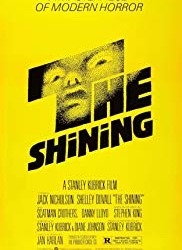
Before we go any further, I am very aware that The Shining was released in 1980, and thus should be exempt from the perusing of a blog dedicated to 1970s horror architecture. It’s probably the most-mentioned movie from friends asking me to cover a film, and I’ve been pretty dogged about sticking to my script with 1970s movies. But maybe I’m feeling generous, as we’re about to put this last decade to bed (and I never really figured out what to call it - the Twenty-Tens? Nope. The Tens? I don’t think so). Anyway, The Shining is one of my earliest favorite horror flicks, based on a book from one of my earliest favorite horror writers. And technically, Stanley Kubrick shot the bulk of his adaption of Stephen King’s 1977 book in the ‘70s. In fact, it could be argued (and will be in fact be argued forthwith) that The Shining is the last of the great 70s horror movies, and very different in tone and setting from what characterizes most 1980s horror films. What is this criteria, you ask? I’m so glad you asked!
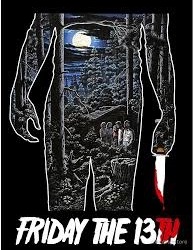
The great 1970s architecture horror flicks tend to be set on stately country manors (most of The Omen, the beginning of Don’t Look Now), stylish city apartments/lofts (Audrey Rose, Sisters, Profondo Rosso), or otherwise sophisticated urban or bucolic location, such as a dance academy (Suspiria). In contrast, many of the iconic 1980s horror flicks are set in manufactured wilderness (the Friday the 13th and Sleepaway Camp franchises), or safe suburbia (the Poltergeist and Nightmare on Elm Street franchises). These are spaces for children and teenagers, with nary a cocktail tray or curated window treatment in view. I’m pretty sure the transformation occurred because the target audience shifted to that age demographic, but it also does speak of the 1980s flavor of paranoia versus the 1970s psychosis. The 1980s were all about outsiders (slashers/monsters) attacking safe traditional spaces, where the settings of 1970s horror flicks were somewhat sinister themselves in their old-world elegance.
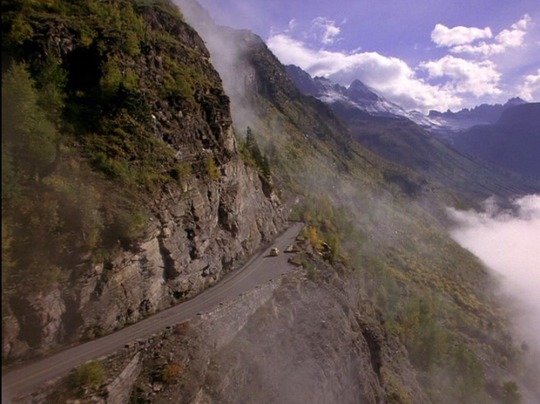
And speaking of sinister, Kubrick and cinematographer John Alcott did a wonderful stitch-up with the opening vista. Ariel shots from a helicopter above Going-to-the-Sun Road in Montana’s Glacier National Park are cobbled together with a wide view of Oregon’s Timberline Lodge, which served as the exterior shots of the fictional Overlook Hotel. I shall pause here to note that these endeavors, both park and hotel, exist courtesy of FDR’s Works Progress Administration. I first visited Timberline Lodge almost exactly 18 years ago while spending the Thanksgiving holiday in Hood River with my sis, bro-in-law, and nephew, and got to visit Glacier for the first time this past September (a lovely side trip after my brothers-in-laws’ wedding), and I gotta admit, I find nothing scary about democratic socialism. The WPA was responsible for providing work and hope to a lot of desperate people during the Great Depression, and leaves as its legacy some of our loveliest landmarks in America.
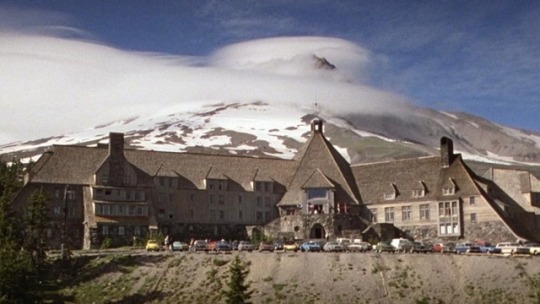
In contrast, the Stanley Hotel in Estes Park, Colorado was Stephen King’s inspiration for the Overlook. The Stanley was built by Freelan Oscar Stanley, of Stanley Steamer fame. Stanley the Steamer decided the local accommodations (where he fully recuperated from tuberculosis) were a bit too “rustic,” and the social scene too “relaxed,” so he built himself an exclusive enclave for the rich. Bully for you, Freelan.

The Overlook Hotel existed mostly as a set in Elstree Studio in England. Kubrick and production designer Roy Walker purposely set out to make the Overlook an amalgamation of bits and pieces of real hotels, rather than giving it one single design aesthetic. The red men's bathroom was modeled on a men's room in the Biltmore Hotel in Arizona (often credited to Frank Lloyd Wright, but in fact designed by his student Albert Chase McArthur).

The Colorado Lounge (that serves as Jack’s writing studio) was based on the lounge of the Ahwanee Hotel in the Yosemite Valley. The set of the Colorado Lounge ended up burning down; apparently, the fire was caused by the intense wattage of the set lights needed to make the interiors appear day-lit from sun reflected off the snow.

The Overlook also does not follow any laws of physics: rooms that should be wholly interior have windows, and hallways and floors don’t make any sense directionally-speaking. This disorientation helps to build the feeling of disquiet and unease in the early scenes. There’s a really worthwhile analysis of this and other Kubrick krazy-ness on YouTube by Rob Ager.
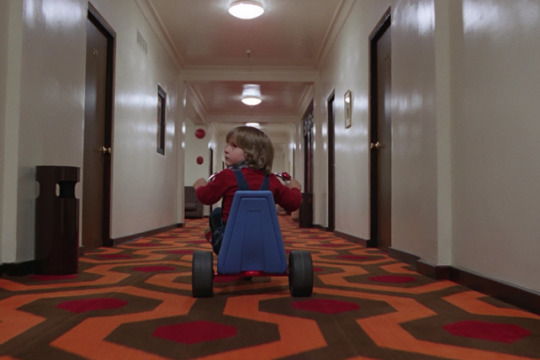
Before we break, here’s one last thing to chew on: the iconic carpet that Danny spins down on his Big Wheel was created by David Nightingale Hicks, the hot designer of the Swinging Sixties. The carpet wasn’t commissioned for the film, but in fact was in existence for about a decade prior. That particular pattern of brown, magenta, and orange is now licensed as Hick’s Hexagon, and you can buy a square for your own pad. Or (the more affordable option) you could just get a pair of socks. Kubrick was already familiar with Hicks’ work, though. The filmmaker featured the Chelsea Drugstore in a Clockwork Orange, a space designed by Hicks and the architectural firm he worked with (Garnett Cloughley Blakemore). Here’s a weird rabbit hole I fell down while researching: Hicks was married to Lady Patricia Mountbatten, the daughter of Louis Mountbatten, aka the First Earl Mountbatten of Burma, aka the last British Viceroy of India, and the man who oversaw the partition of that country into a separate Muslim state of Pakistan. It can be reasonably argued that Mountbatten’s clumsy transition to partition hastened the deaths of thousands during that period, as Hindus and Muslims scrambled to establish themselves in friendly territory. The bloodshed continues today in the two countries’ battle for control of Kashmir. Maybe something to ponder in concert with the image of an ocean of blood spilling from the elevator onto the brightly patterned floor? Another fun fact: Lord Mountbatten was assassinated by the Provisional Irish Republican Army 40 years ago.
Well, um, on that cheerful note, here’s to 2020! To be continued...
4 notes
·
View notes
Text
The House with the Laughing Windows

Pupi Avati’s The House With The Laughing Windows is a relative unknown in the giallo genre. This slow creeper lacks a lot of the splash or star power of contemporaries like Profondo Rosso (Deep Red) or The Cat o’ Nine Tails, but there’s gold to be mined if you stick with it. The namesake architecture is not as jaw-dropping as the settings of many giallo flicks, but the art and archetypes in this movie make it well worth exploring.
Released in 1976, the film is set in a tiny village in northern Italy’s Ferrara province in the Emilia Romagna region. It was shot in the beach town of Valli de Commachio, and more specifically, around one of the seven beaches, Lido degli Scacchi (The Beach of Chess). The plot premise is that Stefano (Lino Capolicchio) is summoned by this remote village to restore the church’s fresco of St. Sebastian. After Stefano arrives in town via ferry, he rides with the mayor past what I think is Ponte dei Sisti, one of Commachio’s six iconic bridges.

Built in the 18th century, Ponte dei Sisti is basically one of the newest bricks on the block; Trepponti (Three Bridges), which is the symbol of Commachio, was built in 1638.
Stefano checks out his commission, and appears to have his work, er, cut out for him. The painting of St. Sebastian is a fucking nightmare even without the flaky build-up.

This martyr’s visceral suffering is a far cry for help from Botticelli’s sexy St. Seb...

Meee-yow. Stefano soon runs into an old friend, Dr. Antonio Mazza (Giulio Pizzirani), who (coincidently!) recommended him for the job. Stefano learns that the commission’s original artist, Buono Legnani, was a deeply disturbed man, obsessed with painting human subjects on the precipice of death. Legnani earned the moniker “Painter of Agony” for this interest. There is this amazing gender-fluid self-portrait in the local inn’s restaurant, the body model blithely introduced as the innkeeper’s wife.

(The wife herself is a creepy creeper, always pausing in doorways and on grassy bluffs to blaze a glare at the viewer.)
Antonio is not long for this world, though - he calls Stefano squawking with some urgent information he’s discovered about Legnani, but takes a swan dive out his hotel window before imparting this tidbit. Stefano doesn’t buy the polizia’s party line that Antonio committed suicide (for one, he saw a shadowy figure in Antonio’s window, post-swan dive). Stefano is immediately kicked out of his hotel room for vague reasons, and creepy church-lurker Lidio (Pietro Brambilla) takes him to live with a paraplegic old lady outside of town.
There’s a lot of care with many of the shots, like this one of Stefano speaking with the old lady. My in-house art expert thought this shot looked like a Vermeer, and I must agree.

The shot of Stefano discovering Legnani’s old studio reminds me of the famous shot in Rear Window where the screen goes from black to a slice of light, as the killer opens Jimmy Stewart’s door:

And also of the early works of misunderstood Metaphysical painter Giorgio de Chirico:

Post World War II, de Chirico was accused of supporting the fascists in Italy, but over time it’s been revealed that Giorgio didn’t support much of anything except his own whims and commitments.
Anyway, Stefano continues to chip away at both the mural and the mystery of Legnani. He squeezes in a romance with the beautiful schoolteacher Francesca (Francesca Marciano) and plies the town drunk Coppola (the fantastic Gianni Cavina) with grappa for information. Stefano is told that the Painter of Agony is presumed dead. As the official archives tell it, Legnani self-immolated, yet still managed to dash off into the woods, never to be seen again. La madre di Stefano non ha allevato alcun pazzo, and he doesn’t fall for that bullshit either. Francesca becomes increasingly uneasy in the house, and begs Stefano to leave town with her. He agrees, but just can’t resist a little last-minute detective work.
Coppola takes Stefano to the Legnani’s last known residence, the House with the Laughing Windows, ta-fucking-da. Let me pause here to reiterate that Avanti does some beautiful work and this film is gorgeously lit with really thoughtful shots; however, the art (Legnani’s art) is kind of... garbage? I guess the St. Sebastian mural is effective in conveying the necessary horror, and I don’t really mind that it looks like a total thrift store art score. But the house itself lacks any menace - like, The Rolling Stones logo is way more scary that those window lips. And then there’s some sad flowers and mushrooms (?) slapped on like an afterthought.
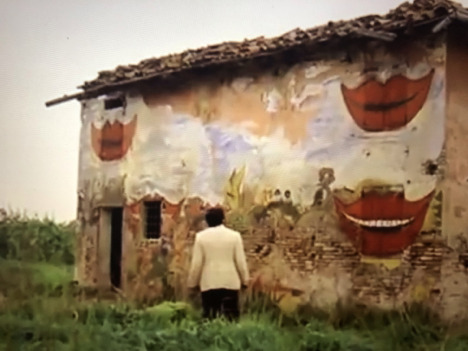
But no matter, because what Coppola is digging on is not the house, but rather a large mass grave surrounding the house. He shovels up a few bones to show Stefano. Stefano, sufficiently convinced that Dodge needs to be gotten the fuck out of, heads back to fetch Francesca.
Ouch, damn. Stefano get the worst “while you were away” message of all: Lidio the Lurk-cules has raped, stabbed, and strung up the poor sweet Francesca. Stefano fetches the polizia but they are led on a fruitless search for evidence, for the crime scenes are sans Francesca corpse or mass grave. Meanwhile, poor Coppola’s drowned body washes up, but his death is chalked up to an alcoholic misadventure.
SPOILERS: Stefano gets lured back to his house, only to find Legnani’s sisters ritualistically murdering Lidio. The sister Formerly Known As Paraplegic Old Lady shows Stefano her brother’s corpse preserved in formaldehyde. The sisters learned some dark rites in Brazil, and they plan to communicate with their dead brother via sacrifices. Second sister sneaks up on Stefano and gets a good chest stab in, but he manages to run away and hide in the woods until dawn.

I think the ending is my favorite part of this film - it’s an allegory of Italy’s fascist past painted in vivid giallo-vision. The injured Stefano crawls from the woods to seek assistance door to door. He first knocks at the inn, but the innkeeper and his creepy-weepy wife turn away from the window. Stefano then seeks shelter from the mayor and the police, but no one answers his pleas for help. He finally heads off on Coppola’s bike to the church, and collapses, babbling, in the priest’s arms. It is then revealed that (holy shit indeed) the priest is second Legnani sister herself! Worst confession ever. Say as many Hail Marys as you want, Stefano, it won’t save your ass from this corruption of church, state, and community.
Happy Halloween! I thought I was done with this blog, but I keep on-a watching da movies and ruminating on da architecture (or art, in this case).
1 note
·
View note
Text
The Eyes of Laura Mars
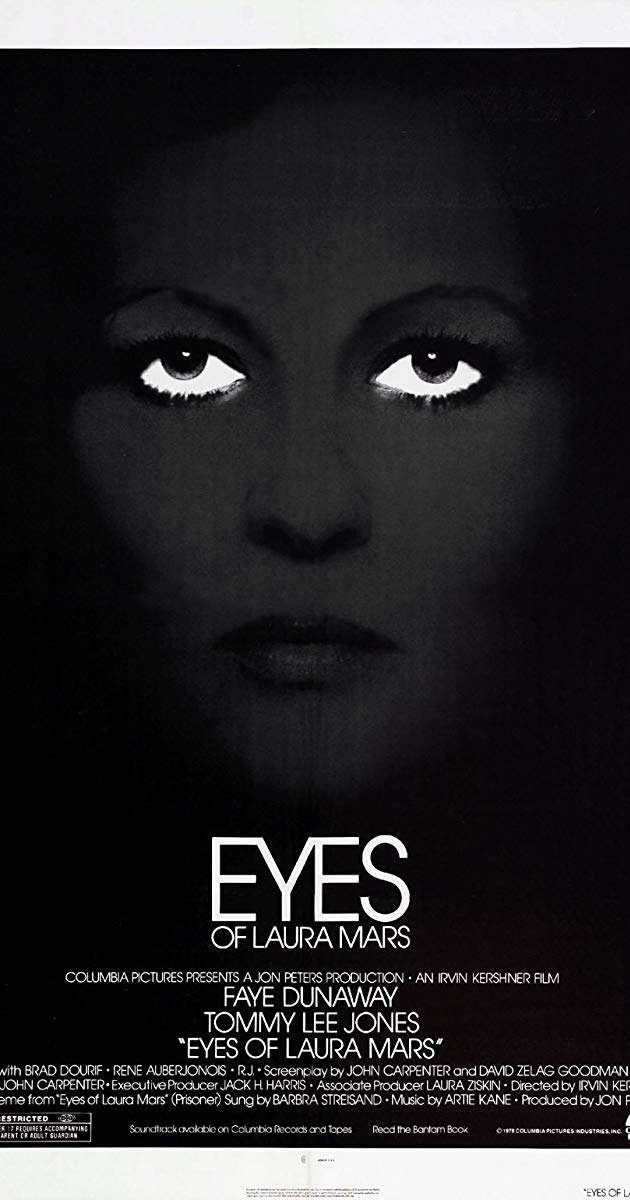
Released in 1978, The Eyes of Laura Mars is set in the glimmering yet gritty world of NYC haute couture fashion. Mad Magazine parodied the film as “The Eyes of Lurid Mess” and rightly so, for it definitely has plot issues and some grade-A-Virginia-ham overacting. However, director Irvin Kershner managed to capture a whiff of the cultural crossover as the NYC scene shifted from disco to punk. Often touted as the first American giallo film, The Eyes of Laura Mars tidily ticks off the boxes of the Italian genre: a mix of gorgeous and grimy settings, the gruesome murder of beautiful people, and many misdirections before the killer is finally revealed. Added to the mix is Ms. Virginia Ham herself (Faye Dunaway), a hairy Brad Dourif, and a preternaturally prehistoric Tommy Lee Jones. Dourif is only four years younger than TLJ in real life, but he looks like a bearded baby next to TLJ’s tire-treaded brow. Hell, TLJ is six years younger than Dunaway, but there’s not even a scratch of the cougar in their relationship.
Faye Dunaway of course plays the main character, a superstar high fashion photographer who begins to have disturbing visions of murder. Fun fact: the actual images of famous fashion photogs Rebecca Blake and the so-called “King of Kink” Helmut Newton were used in the film.
Speaking of kink, Barbra Streisand was offered the main role (it helped that she was dating producer Jon Peters at the time) but turned it down because she thought the film’s violent, sexual content was too out-there for her image.
The film opens with a murderous sequence, which turns out to be one of Laura’s nightmares. She awakens in her rather spare and severe bedroom,
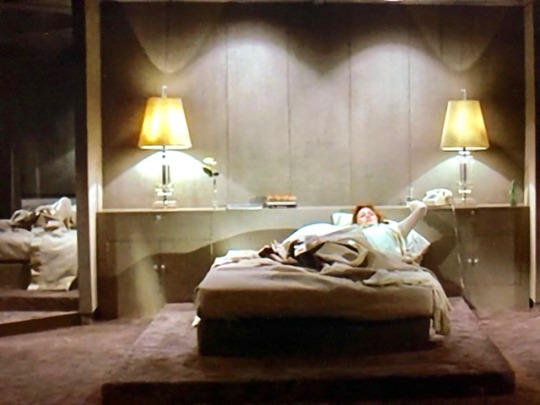
and then wanders out to her living room, aka The Neutral Zone. Beige and brown rule the day, as does that giant rooster sculpture. From kitchen kitsch to highbrow decor? Huh. And oof, so. Much. Carpeting!
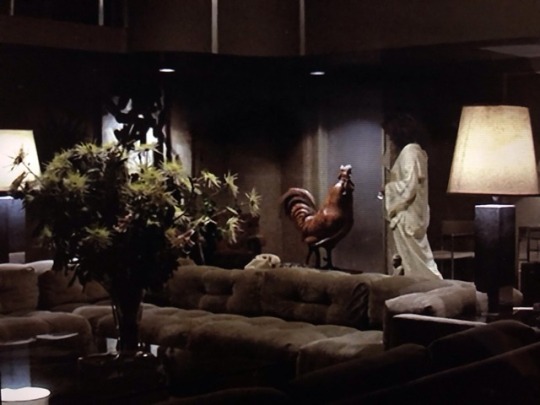
Laura flips through some negatives and tries to put the nightmare behind her. Soon, driver Tommy (Brad Dourif) is ferrying Laura off to the gala reception for a new publication of her photos. It looks like maybe the exterior was shot at one of the Metropolitan Museum of Art’s side doors. The interior looks somewhat Studio 54-inspired, though.
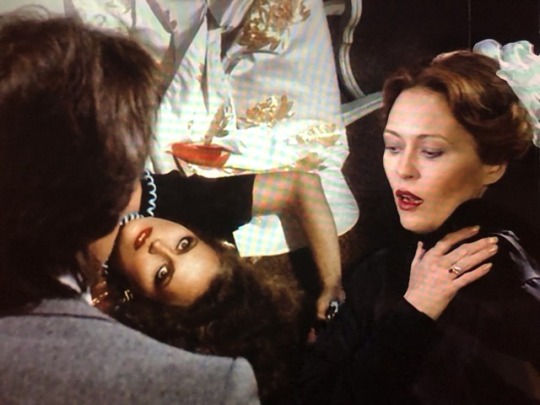
Hiiiiiiyyyyyeeee! I’m just a photograph, don’tcha worry.
Laura meets cute-ish with Detective John Neville (TLJ), as cute as can be when one’s publisher has been horribly murdered with an ice pick. Neville came for the questioning, but he stayed for the hors d’oeuvres, or rather, he looks a bit hungry for a Mars Bar. Laura goes home and rings up her bestie, who happens to be dating Laura’s ex-husband Michael (a very slimy yet somehow sexy Raul Julia). Everyone calms each other down, and soon enough, Laura heads off for a shoot at Columbus Circle. The concept is a bit S&M, models in lingerie and furs fighting in front of the husks of burning cars...
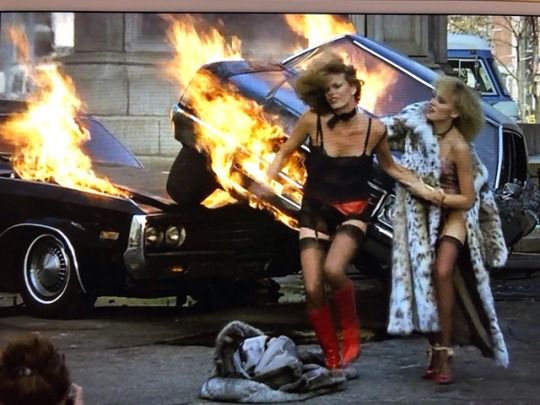
The concept was inspired by photog Chris von Wangenheim, and so fitting in front of what my father once called “The Devil’s Arsehole” (don’t feel special, C.C., he said that about every Washington D.C. roundabout too). The intersection didn’t get the moniker until 1892, the 400th anniversary of Columbus’s “discovery” of the New World, when a giant statue of the old man was erected. From the invention of the car on, Columbus Circle was considered a hazardous spot for pedestrians. Given the circle’s bad rap for most of the 20th century, it seems quaint to remember that Olmsted intentionally designed the traffic circle as the grand entrance to Central Park in 1857. By 1978, Columbus Circle was “roundly” (oh ho ho) derided as a dangerous thoroughfare. In 1979, architecture critic Paul Goldberger said that the intersection was "a chaotic jumble of streets that can be crossed in about 50 different ways—all of them wrong." A redesign of the circle’s aesthetics and traffic flow began in 1991, and by the Naughty-Aughties, Columbus Circle had even won a few awards for landscape architecture and urban design.
Neville shows up again at Laura’s set at Chelsea Piers. This is my favorite set in the movie, with the fabulous Sterling St. Jacques dancing around and a lot of blown-out color and drama going on.
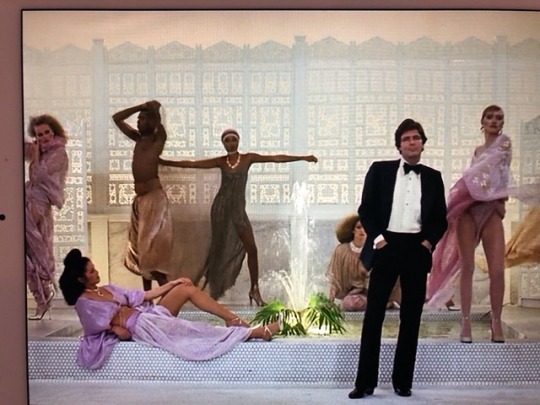
It’s also one of our last scenes with poor Lulu and Michelle, alas. I actually quite like both of their characters, so silly and yet so sassy. They have the best outgoing answering machine message, and it made me feel so nostalgic for both answering machines, answering machine messages, and that kind of close relationship you’d have with a roommate. That is the kind of relationship that can only be built after hearing all your messages, and knowing all your secrets, unvarnished and unedited by a brunch re-telling. Sigh.
Laura’s studio is amazing - it’s enormous with tons of old windows, stunning harbor views, and some convenient soft spots that are perfect for sexy times with Neville.

Donald (René motherfucking Murat Auberjonois) is such a great character. He’s Laura’s long-suffering agent, and although at times walking the stereotypical line, he is quite comfortably un-closeted. Whenever someone tries to throw homophobic shade his way, he shines a light right up their asses. I do not love the character’s decor choices, though - a bit too Italianate for me, although who can resist a red damask wallpaper and this goddamn face? Not me, friends.
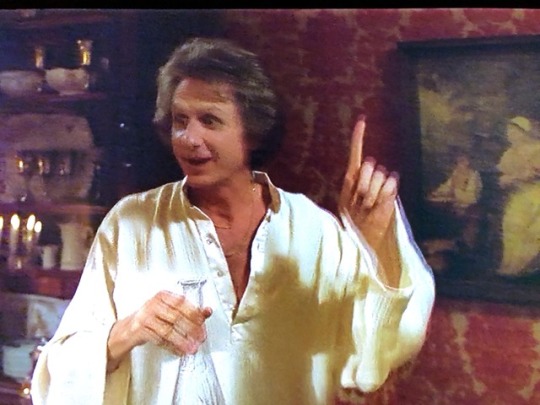
Speaking of Italian classics, Frank Adonis makes an appearance as Sal, Neville’s slightly unhinged partner. I like this shot of him surveying Laura’s apartment with a “mmm, not bad,” expression.
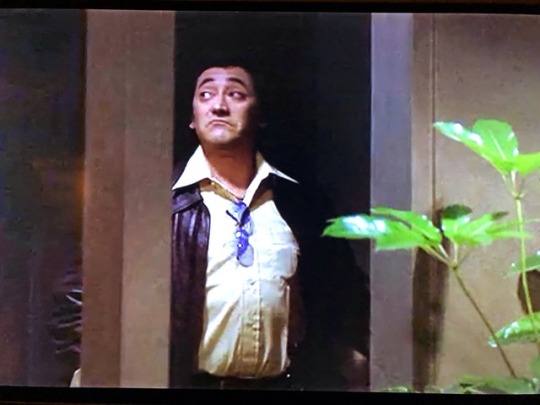
Frank just shuffled off this mortal coil in late 2018, R.I.P. Weird fact: although he’s the Italian guy you recognize from everything, his Wiki page is in French.
SPOILERS, sort of: Neville goes to see Tommy at his spectacularly depressing apartment, and the visit quickly takes a turn for the worse. Tommy stabs a patrolman while escaping arrest, but the Sal the psycho just opens fire on what appears to be the entire East Village, and Tommy est la morte. Neville rings up Laura to tell her the killer has been caught, and pack your bag, baybeee, they are going away! Laura begins to select some careful neutrals to coordinate with the lady Derringer gifted by Neville, when she is suddenly struck by another vision.
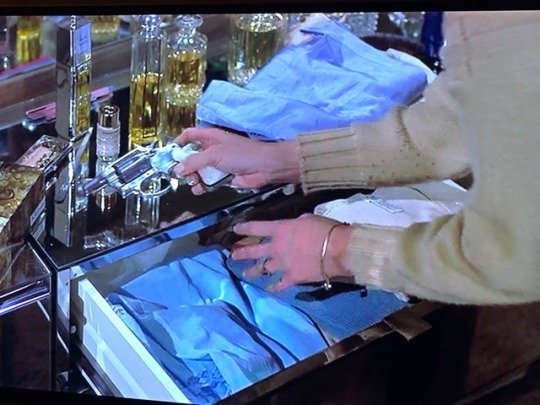
Poor Michael gets ‘picked in the elevator of Laura’s building, and the killer is en route to her apartment! Laura manages to lock the front door just in time. Neville soon comes crashing through the balcony window, and this is where the ending gets super giallo: as he begins babbling about Tommy’s terrible upbringing, Neville accidentally reveals that it is he, Neville, who is the killer. But it’s not really Neville! No, it’s his other personality that did the killing. That personality is also apparently responsible for how nicely Neville fills out a black turtleneck, as well as for finishing Neville’s dissertation and keeping the bills paid. The real Neville struggles back to the surface; to protect his true love, he basically shoots himself using Laura’s gun (and trigger finger, as she is holding said gun at the time). The final shot is of Laura calling the cops, and her final line? “I’m Laura Mars.” If there is any shred of happy ending to this story, it might be that she has to rip out that fucking bloodstained carpet. Maybe there’s a nice parquet floor under there? I know that hating on carpeting is low-pile fruit, but there is just no way for mere mortals to keep wall-to-wall carpeting from getting disgusting.
Interesting fact: John Carpenter wrote the spec script for this film, but Kershner’s finished product took some hot turns in the rewrite. Carpenter was still credited despite his protests, but luckily the mixed reviews didn’t affect the success of his next project, Halloween. It’s been nice to revisit some giallo, although I think I’m going to go back to the real-deal Italian giallo next month. I might also be leaving this platform, as sad as that makes me. Tumblr has been doing some bullshit flagging of posts that are very LGBTQ-unfriendly, and well, they are also buggy as hell. I had this post written a week ago but the site kept crashing as I was trying to update. At any rate, stay tuned for any updates, or as I likely know all three of you reading this, I’ll let you know if there’s a new site.
4 notes
·
View notes
Text
The Exorcist
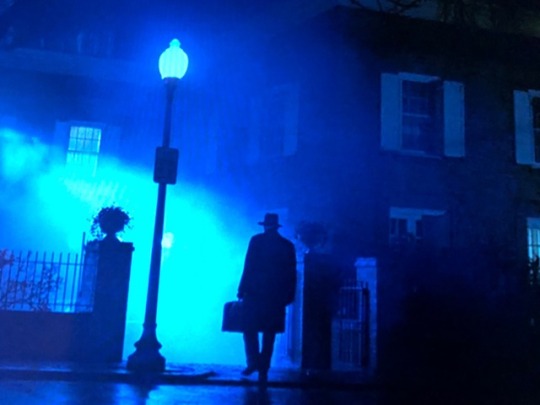
William Friedkin’s horror masterpiece, released 45 years ago this holiday season, was largely set in the collegiate Washington D.C. neighborhood of Georgetown. The Georgetown of the early 1970s was a bit less posh than the neighborhood today, but even at the height of the eponymous school’s frattiest years, the area was chockablock with Federal-style and early American architecture. The university itself is heavily featured in both book and film (author William Blatty was an alumnus), as are establishing shots of the Key Bridge (formally, the Francis Scott Key Bridge, built in 1923) that spans the Potomac.
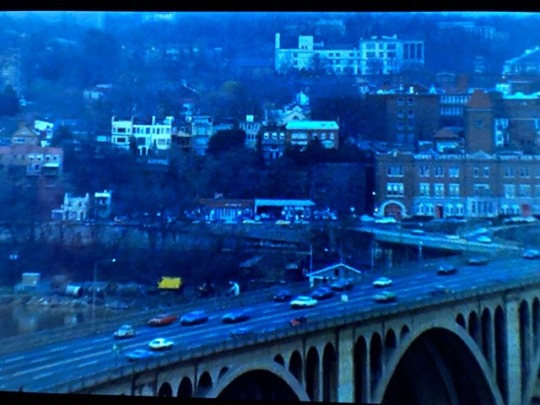
The infamous “Exorcist Steps,” which run from Prospect down to M Street, were even honored as such by the city in a 2015 ceremony.
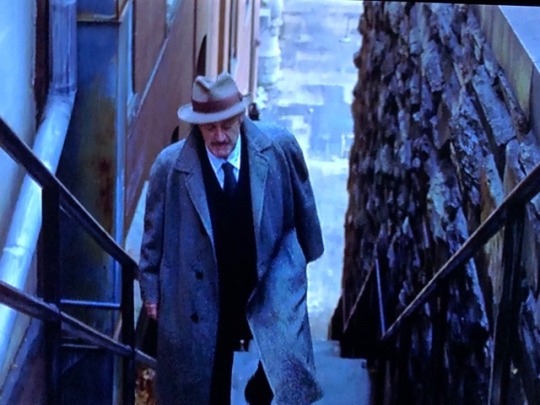
As previously established, I was raised Catholic-lite: First Confessed but barely Confirmed, aka Catholic enough to be disturbed by the Exorcist but not Catholic enough to have picketed the movie. Although in 1973 I was but one year old, and that would have been a very tiny and cute picket sign in my chubby fists, maybe “Former Fetuses Against Friedkin” or something like that. Anyway! I first watched the Exorcist with my atheist-raised high school bestie, and at the time we both agreed that it was just unsettling enough to raise some doubts about God and the Devil. Also about the wisdom of fucking around with a Ouija board.

No girl! Captain Howdy is not your friend, ma petite.
My second viewing of the film was as a full-grown adult, when the director’s cut was released in 1999. I now realized the true horror of this story was just under foot: the ugly carpeting in that awesome Federal-style townhouse!

The MacNeil residence’s main floor has herringbone parquet in the kitchen, dining nook, and study, but the rest of the house is covered in that ugly-ass, low-pile fuzz bomb. I could barely register Regan’s infamous spider walk down the stairs, I was so distracted by that gross carpeting.
I couldn’t stop thinking about it. Why would you ruin such a historic property? How could you commit such high crimes against the herringbone? But then I did some research, and sigh, I was all wrong. You see, the Exorcist house, aka the MacNeil Residence, wasn’t built until 1950.
Thus, that carpeting makes total sense, as does Chris MacNeil (Ellen Burstyn)’s bedroom style.
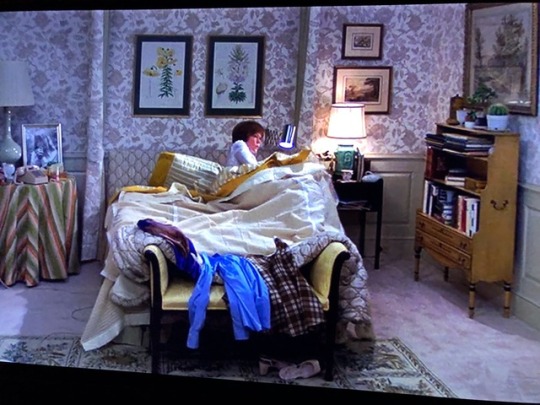
The furniture is Federal-style but the wallpaper and (blech) carpet are definitely 20th century.
Regan doesn’t seem to be into carpeting much, either, given her tinkle on the Persian rug. I just love the reaction expression on Father Dyer’s face after Regan pisses the floor. By the way, that character was played by a real live priest, Father William J. O’Malley:

Speaking of priests, Father Damien Karras (Jason Miller) pretty much wiped out any remaining Catholicism lingering in me. I never met a priest half as handsome, and thus that confirmed that there must be no God.
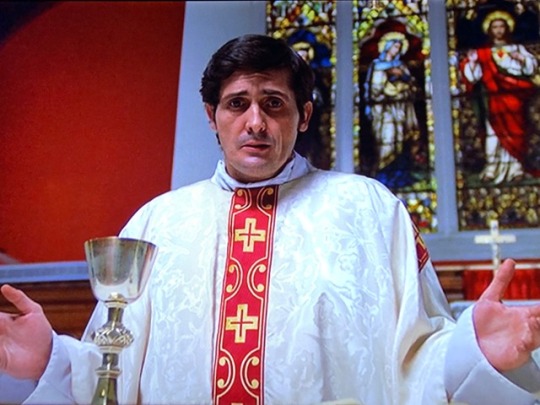
Mon dieu, he is a tasty sacrament. O la la...
There was so much myth and legend surrounding The Exorcist, it’s sometimes hard to remember there was some bona fide weird shit happening as well. An actual serial killer makes an appearance in the film (okay, alleged serial killler, but convicted murderer). Friedkin shot the hospital imaging scene at New York University Medical Center, and used an actual neurosurgeon and his team as extras. Paul Bateson was an X-ray technician on staff at the hospital and made it into the scene, with a line to boot.
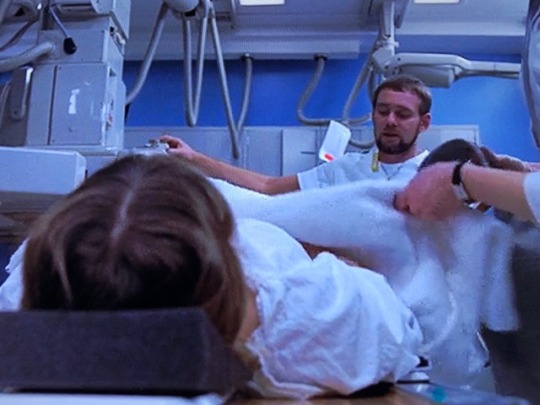
Bateson was arrested in 1979 for the murder of film critic Addison Verrill (an act committed during a date gone terribly wrong). While incarcerated at Riker’s, Bateson boasted to other inmates that he had murdered at least six other gay men. The details he provided were eerily similar to the “Bag Murders” that had terrified the NYC gay community in 1977 and 1978, when the bodies of missing queer men turned up in the Hudson River. The victims were all dismembered and disposed of in plastic bags, just as Bateson described. The police were never able to assemble enough evidence to charge Bateson, so he instead only served his sentence for the death of Verrill. William Friedkin had already been approached earlier to shoot a film based on the 1970 novel Cruising, but he passed on the offer until the Bateson arrest. Friedkin was so disturbed and intrigued by this story and his own connection to the murderer, he ended up making the film.
There are a lot of other fables about the Exorcist curse, which are mostly explained away easily. I personally was a bit haunted when doing my research, thinking about Georgetown Preparatory School and this past year’s shitshow Supreme Court nomination hearing. Even though Georgetown Prep separated from the University and moved to Bethesda, MD in 1919, the name is still triggering. Dr. Christine Blasey Ford still cannot live in her own house, due to death threats, and the accused sits clear and free on the highest court of the United States. Believe women. Why the fuck would we go through this torture a second time, if we weren’t telling the truth?
Here’s to hoping for a better 2019. I made it through a year of blogging about my special obsession, hurray! I’m going to keep this going as long as there are interesting architectural examples in 1970s horror movies. January is going to get weird, so stay tuned. I love you all, you sexy demons. Tabernak!
2 notes
·
View notes
Text
Play Misty For Me
So we’re going to close out November with the directorial debut from Dirty Harry, good ol’ Clint Eastwood. Play Misty For Me was released 47 years ago this month and it is a legit creeper of a film. Eastwood does a solid journeyman’s job here: the thrills are earned and the suspense is tight, and he doesn’t try any tricks outside of his toolbox. I have some issues with plot and character development, but we will get to that soon enough...

The story was originally set in Los Angeles, but the future mayor of Carmel-by-the-Sea decided he wanted to shoot in his backyard, and I must concur with that decision. It’s a gorgeous area, 120 miles south of San Francisco on a dramatic stretch of the California coast. Spanish explorer/exploiter Sebastian Vizcaino “discovered” the area in 1603, and he named the area after the Carmelite monks who accompanied him on his journey. However, due to some political maneuvering bullshit, the area didn’t really take off until Mission San Carlos de Borromeo was founded much later, in 1771.
It is a testament to the the area’s rugged terrain and remote beauty that Carmel took so long to develop, not until Amazon Prime was invented. J/K! No, Carmel-by-the-Sea really took off after artists from San Francisco and elsewhere descended to partake of the area’s said remote beauty. Much how Donald Judd and his ilk reshaped Marfa in the early 1970s, Carmel quickly expanded as an artist colony in the early 1900s. There’s a theory that the San Francisco earthquake of 1906 is what drove creative types like Jack London, Sinclair Lewis, Mary Austin, George Sterling, and Robinson Jeffers to the area. The reality (or realty) is that developers Frank Devendorf and Frank Powers came in 1900 and bought up most of the available land. The Franks formed the Carmel Development Company, and though the area could only be accessed at the time by stagecoach, the Carmel Development Company knew their market. They reached out to northern Californian teachers and artists, selling the town as a coastal oasis outside of the city. It worked. There are some really cool houses that were built in the early days of Carmel’s development.
By the time Play Misty For Me was filmed, Carmel was a well-established arts community. It was popular with counterculture creatives as well as a holiday home for wealthy art lovers. The film opens with an aerial shot of a remote cliff side house.

The camera zooms in to find Eastwood, a.k.a. Dave Garver, wandering around outside. He peers in and we see a painting - of him?


Ooh, that’s not a good painting. Dave jumps in his Jaguar convertible and speeds off over the Bixby Creek Bridge to his job as an overnight radio host, which somehow pays enough for that seriously sweet ride.

That font is hella bad, I think - very Rat Fink, and no shade on Big Daddy Roth, but maybe not for this movie?
After a shift of mixing jazz with toneless poetry readings, our man Dave is thirsty. He heads over to the Sardine Factory (which is actually in Monterey and still in operation, thanks very much). There he meets Evelyn, a young and foxy Jessica Walter (a.k.a. Lucille Bluth). Dave and the bartender spin a little flimflam to spark Evelyn’s interest in Dave, but we soon learn who is the spider in this web.

It turns out Evelyn is a groupie who calls Dave’s show nightly to request the song “Misty.” She and Dave go back to her little bungalow (super cute but I couldn’t get a good shot) and sleep together. It also turns out that Dave is hung up on his ex-girlfriend Tobie (Donna Mills in a very unfortunate shag-mullet haircut).

He leaves his tryst with Evelyn and hunts down Tobie after sweet-talking her whereabouts from her roommate. We find that the relationship soured because Dave was often unfaithful to Tobie. We also learn that Tobie is the one who lives in the awesome cliff side house, which her dad left to her along with the mortgage. Dave seems to justify his affairs because Tobie hosts a stream of never-ending roommates, which Tobie sensibly explains are necessary due to that mortgage. Listen, dickhead, you wouldn’t even know Tobie was back in town if her roommate didn’t tell you! Also, I like when a movie or television show is honest about financial realities, and the reality is that Tobie is not a great artist. She appears to dabble in oils and metalwork and a few other approaches, but maybe, girl, pick a medium? Also, she leaves her blowtorch lit at the studio when she wanders off with Dave. WTF? Although Dave is a kind of shitty DJ working in a lower-tier radio market, and he gets to live alone and drive a nice car, but hey, that checks out re: male white privilege.
Speaking of, Dave continues in the dickhead vein (yowza) and sleeps with Evelyn again a couple of times. See, Evelyn shows up at his place with a bag of groceries and an offer to cook him steak, and well, Dave just can’t help himself. I can’t find much information about Dave’s house so I guess it was probably a set, but it’s cool as hell. There’s a courtyard pond that you have to cross on stepping stones,

and the inside contains walls that are possibly goldleafed?


There’s also a penny-farthing bicycle. Huh. I would pay good money to see Clint Eastwood wobbling around on a penny-farthing. Anyway, Evelyn reveals herself to be a seriously disturbed chick. I have to admit, I had a lot more sympathy for her this time around watching it. Dave treats her like garbage, and completely disregards the warning signs of her mental illness. Eventually, Dave tries to break it off and Evelyn slices up her arms. She also slices up the cleaning woman, and gets taken off to a mental institution. Dave and Tobie get back together and everything’s great, until Tobie has to leave the Monterey Jazz Festival early to pick up her new roommate. Yup, it turns out that Evelyn was working those classifieds like a boss from the loony bin, and she has Tobie right where she wants her. Evelyn gives Tobie a much-needed haircut and does a little more slicing on a detective and Dave, before taking a scenic tumble over the railing. Fin.
Tobie’s pad in the movie is a real house, and it sold for over $5,000,000 about five years ago. It was last listed in 2017 for over $11,000,00. Speaking of played, I think the renovation was a bit meh, but I also think $11,000,000 for a three bedroom house is obscene. It’s only been a year but a lot of what they did looks dated already, and super bland and Ikea-ish (again, no shade on Ikea, but for 11 mill I would demand some higher-end fixtures). Listen, I am not a total rube - I know you’re paying for location and view - but I reserve the right to get angry about this shit.
Next month, we’re heading back to the other coast - a virtual swamp, by some accounts - and excavating a classic horror movie.
2 notes
·
View notes
Text
Don’t Look Now
Happy Halloween! 45 years ago this month, Nicholas Roeg released his gothic horror about life’s big questions: does the spirit exist after death, or are we just reduced to dust and bone? And speaking of bone, did Donald Sutherland and Julie Christie actually get down and dirty on screen?
But we’ll get to that soon. The film’s locations were set primarily Venice, Italy but there’s a good bit shot in Hertfordshire, England, two spots a world apart in everything except beauty. The film opens in the English countryside, where John Baxter (Donald Sutherland) and his wife Laura (Julie Christie) live with their daughter Christine (Sharon Williams) and son Johnny (Nicholas Salter). Their house vibes on a particular ‘70s English manor artsy-hippie style, all leaded glass and stone fireplace, but modern furniture pieces mixed into a creative arrangement.

It’s a rather unusual looking house from the outside, I think, with the dual sidings of wood and brick. The location, Baas Hill, was the home of actor David Tree, who played a small role in the film. From what I’ve read, the building was added onto over the centuries and thus is an amalgamation of architectural periods ranging from 15th century to 18th century. But alas, daughter Christine drowns in the (incredibly scenic) pond, in a nightmarish scene that shows off Sutherland’s acting chops. The Baxters pack wee Johnny off to boarding school and head to Venice to... drown their sorrows? No, John is overseeing the restoration of a cathedral (San Nicolo dei Mendicoli, which was actually being restored at the time of the filming, and thus Roeg scored some free scaffolding props).

Laura is along for the ride, but doing the British stiff upper lip thing and barely holding it together, at least until she meets a strange pair of sisters. Wendy (Clelia Matania) is touristing through Venice with her blind sister Heather (Hilary Mason).

The sisters encounter Laura in a restaurant bathroom, where Heather tells the grieving mom that she can see the spirit of dead Christine between the Baxters. Laura politely processes the information, returns to her table, and passes out. Naturally, John refuses to believe this “mumbo-jumbo.” However, he is experiencing flashes of deja vu, and dealing with some very anti-OSHA work practices at the church restoration.

Yeee-ikes. Meanwhile, a serial killer is terrorizing Venice. Laura, though, is a new woman. She is cheerful, happy, and more than a bit randy, thus initiating the infamous love scene. I have to admit, I really don’t care if Christie and Sutherland had actual sex during the filming, just like I really don’t care that Ray Davies has denied that “Waterloo Sunset” was inspired by the romance between Julie Christie and Terence Stamp. Davies has now put out several conflicting stories about the subjects of his best song (arguably, one of rock’s best songs), and listen up, Ray, you crotchety man, me think you doth protest too much. I mean, look at these two :

Mr. Davies, it’s okay if you were besotted and wrote a great song about these gorgeous kids, who could blame you? And who could blame D-Suth if he was equally seduced? I mean, look at her, dressing for a post-coital dinner. She is amazing.

Anyway, the hotel where this sexy scene takes place was called Hotel Europa in the film but is actually a combination of two locations. The lobby was shot at the Hotel Gabrielli and the Baxter’s room was set in the Bauers Venezia. The lobby’s shrouded furniture (in anticipation of the hotel’s closure for the season) at once reflects and forebodes the death shroud of the serial killer’s victims.

There’s other recurring motifs, like glass breaking, the color red, and people falling, and they’re all woven together beautifully. Anyhoo, Laura has a seance with the sisters and believes that Christine has contacted her to warn that John is in danger. She is in the midst of trying to convince John to leave Venice when they get a troubling call. Laura has to rush back to England to see about their son Johnny, who has been injured in a fall. John puts her on the vaporetto to the airport, but later believes he sees Laura and the two sisters pass by on another water taxi. John sets off on a chase across beautiful crumbling Venice, searching for his wife. He goes to enlist the assistance of Bishop Barbarrigo (Massimo Serato) and visits the, um, church headquarters with a giant statue of the pope (?) and a nun receptionist in the lobby.

John also visits the Polizia to report Laura’s disappearance. Well, really, he’s reporting her reappearance, I guess, but check out this delirious hallway of offices!

John even gets blind sister Heather detained by the police, only to have Laura call him from England to report J2 is doing fine and she’s heading back to Italy. Boy, is his face is as red as the little figure he keeps spying from the corner of his eye, the one that reminds him of dear Christine. John can’t leave well enough alone, and he soon learns that these hallucinations he’s been having were in fact a psychic vision of his own death.
It might be worth it to die in Venice, though, judging from these hearse boats. This the height of the Roman Catholic funeral! It’s like an urn with an outboard motor.

But don’t look now, Venice might not be around by the time you die, at least not as we know it. When Roeg et crew were filming in the 1970s, the city had already sunk two inches from just the previous 15 years. The city continues to sink at a rate of two to three millimeters per year. On Monday, Venice got hammered again. The high tide was more than 61 inches above average sea levels in the lagoon. This is just another detail in the larger tale that is climate change, which really, is the greatest horror story of them all. There’s one important and easy thing you can do right now to counter this nightmare, and it is to vote. Vote for politicians who will address climate change (as well as the numerous other issues of racism, anti-Semitism, gender inequality, transphobia, and wage slavery). At the very least, vote against those who are gleefully destroying our planet for profit, and raise up candidates who care about something other than their personal stock portfolios. Everyone driving a Prius and composting will not offset the damages of unregulated industry.
Okay, my little rant here is done. Next month, we’ll be visiting another coastal setting, more “misty” than musty, though!
0 notes
Text
Amityville, Part 3
So we last left off with Murray Hamilton smirking like a jerk, putting the poo-poo on the boo. Meanwhile, we have to see this shot of George in the tightness of his whiteness.

How do you wear a long-sleeved undershirt and no pants, sir? Ugh. I also think this chandy (Long Island for “chandelier”) is wicked out of place. Not very Dutch Colonial, ya know?
Speaking of wicked, George later heads down to a watering hole called the Witch’s Brew. Never mind that Henry and Wanda are stinking up the stools, this place has am-beee-yance! There’s even a third-rate Ted Danson behind the bar, fer crying out loud.

Father Delaney is visited in a very nice sanitarium by his old pal, That Other Priest Who’s Name I Can’t Be Arsed to Look Up, a.k.a. Men (of the Cloth) in Black.

Pretty gorgeous spot, eh? It was shot at the Sunken Gardens at Georgian Court University. I guess they’re standard digs for the heir of a robber baron, though.
Kathy does some research and realizes she has five days to decide if these Warby Parker frames will work out.

She races home to ask a second opinion, but George has lost his shit and the house is, um, bleeding? From the wallpaper. As they do.

Kathy must have opted for the bifocal rx because she takes a good look and decides to GTFOOT. George goes back for the dog (which has spent the entire movie either chained up outside or locked in the basement) and gets an oozy dose of payback for poor pet ownership.
The whole family splits and we get this crap epilogue:

The real epilogue, though, is that the backstory of this film is way more interesting than the actual product. Like that Ronald DeFeo’s own defense lawyer, William Weber, claimed that the Lutzs approached him with the idea of writing the book the movie was later based on. The Lutzs, he alleged, apparently dreamed up the idea for the book over “many bottles of wine.” The Lutzs decided to cut Weber out of the action and ended up taking the story to Prentice Hall Publishing. Prentice Hall in turn hired ghostwriter (ohhahaha!) Jay Anson to parse the book out of notes and recordings provided by the Lutzs. Weber then sued the Lutzs for breach of contract, and the two parties settled out of court. There’s many issues with the Lutzs’ account of the haunting, which you can read on the Wikipedia page, but maybe one of the most damning is the Weber settlement. Lawyer jokes aside, doesn’t it seem fairly unlikely that a defense attorney would jeopardize a very comfortable income and risk disbarment by making up this bananas story? I mean, the fight was fairly public, so it’s not like Weber attempted some sort of blackmail payment. I mean, it’s not like he was the president’s attorney or something.
Well, I was annoyed at first, but I think I might have actually enjoyed breaking this post up into parts. Damn it, Tumblr! Likely it’s the Stockholm syndrome or scotch talking, but this 10-photo-limit per post may work out okay. Next one is going to go a little tropical by way of Italy, in keeping with the weather here in Austin. Ciao until then!
1 note
·
View note
Text
Amityville, Part Two
We left the last post with “Lutzs are whoop, whoop, in da house.” Kathy’s good bud Father Delaney comes over to bless the house, and he gets attacked by...flies? Huh. As far as insect attacks, I think that rates much better than “wasp attack,” “gnat swarm,” or “scorpion in the bathtub.” It might rate somewhat worse than “butterfly horde” but really, that’s about it.

Anyhoo, he scoots on out and the Lutzs get some cuddle on in their horrendous bedroom. The story goes that the Lutzs bought the previous occupants’ furniture as part of the deal, but that gold-veined mirrored tile behind the bed? Pure Lutz. I don’t hate it on principal, but much like the Lutzs themselves, it really doesn’t go with the style of the house.

Kathy’s aunt the nun comes to visit - here’s a rare shot of the front of the house. Pretty anodyne stuff.



But soon both the toilets and the aunt start puking everywhere. Here’s the house, appearing to giggle in malevolent glee. Hmm, doesn’t it look a bit cross-eyed? With a row of gnashing teeth and the chimney as a nose. Not a bad shot, all in all.

Then Kathy’s brother is about to get married, but he’s lost the envelope containing $1500 to pay the caterer in cash. It appears the house stole the money!

Yeah, George looks equally skeptical about caterers who need to be paid in cash, and/or houses that lift wallets.

Anyway, it looks like a classic poltergeist heist. I’m not sure what the ghosts want with cash? Maybe, if they are truly evil, they will use that $1500 to replace the awesome wallpaper with faux shiplap. Note: I have nothing against shiplap, or certain home remodeling shows, but I do have a vendetta against people who move into older homes and immediately tear out every period feature. I don’t really believe in ghosts or haunts, or that houses are capable of evil acts like stealing your wedding cash, but I do think that houses are alive, in some strange way. Maybe it’s just the personality of the architect or builder or owner, but there’s a vibe you get when you walk into an older home, one that’s been layered with different lives. Houses reflect their histories. By all means, replace those broken sinks and remediate that lead paint, but try living with innocuous period features for a while, to get a feel of how they fit into your house and your own life.
(Steps down from soapbox, which is quickly repurposed into a garden crate and sold for $74.)
Father Delaney is having a bitch of a time convincing his peers that something hinky is happening at 112 Ocean Avenue. And look who doubts him! Good ol’ Murray Hamilton, a.k.a. Father Ryan.

“The presence of a poltergeist in Amityville? Same odds as a shark in Amity.”

(Photo courtesy of Cult Film Freak)
God, I love Murray Hamilton. I forgot he was in this movie and out-loud screamed in delight when he appeared on screen. Hamilton died only seven years after this movie was released. He was the consummate typecast actor, someone who made lemonade out of being a poor man’s Jack Lemmon. Let us bow our heads in honor of the man, and pour out a Long Island Iced Tea as tribute to that amazing anchor blazer.
Due to some bullshit rules on images per post, we’ll have to call this post a part two of three (or just as promised, the limp bologna of the sandwich). Tune in next time for the conclusion of the Amityville Horror’s architecture tour, a.k.a. “Toasted Bread Wrapped in Tinfoil: Soggy.”
2 notes
·
View notes
Text
Amityville Horror, Part One
I feel the need to cover the Amityville Horror, in part because I’m using the image on my home screen, but mostly because the residence featured in the film might be the most famous (supposedly) haunted house in the world. The film features an iconically scary house in a beautiful setting, and stars a very cute Margot Kidder (RIP, ma cheré)...

And a very curled James Brolin...

as Kathy and George Lutz.

Rod Steiger chews enough scenery to earn top billing as Father Delaney, and there are some delightful supporting actors and interesting settings peppered throughout the film. In short, many of the elements of a great 1970s horror architecture flick are in place. However, I’m going on the record upfront to declare this movie is a dud.

The reason the film is a dud is because the story behind it is also a dud. It’s a hoax, dreamt up by a couple of red-blooded American opportunists who decided to benefit twice from an actual tragedy, namely the DeFeo murders. On November 13, 1974, Ronald “Butch” DeFeo Jr. murdered his parents and four siblings at their home in Amityville, NY.

Prior to the murder rap, DeFeo Junior was reputed to be a substance abuser and a bit of a spoiled brat. No wonder, as DeFeo Senior was an alleged abusive husband and father with Mafia connections. DeFeo Senior hired Junior to work at the family’s successful auto dealership, but Junior rarely showed up for work. He spent most of his time getting high and drinking down at a local bar. This same bar is where Junior showed up on the afternoon of November 13th, claiming he had just found his entire family shot to death in their beds at 112 Ocean Avenue. DeFeo Jr.’s story to the cops soon fell apart, and he was convicted of the murders a year later. He is still serving out the six consecutive life sentences. Mere days after DeFeo’s sentencing, George and Kathy Lutz moved with their three children into the home. The family moved out 28 days later, claiming to have been driven from the house by violent paranormal activities. The Lutzs, it is said, never returned to the house and promptly moved out of state. Much like Butch DeFeo’s defense, though, the Lutzs’ claims doesn’t hold up to scrutiny either.

But we’ll get into that later - let’s put the backstory on the back burner and dish a bit on the house. This three-story, five bedroom and three and a half bathroom house is located in a quiet and quaint part of Long Island’s south shore. The house sits on Amity Harbor and includes a swimming pool, boat slip, and boat house. The $80,000 the Lutzs paid for the house translates to about $380,000 in today’s dollars, but that price was still cheap at the time for the area and property. It sold in 2017 for $605,000, $200,000 under the asking price, but again, that’s a fairly typical price for the home and area. Here’s what it looks like today:

A previous owner successfully petitioned to have the address changed to 108 Ocean Drive, and perhaps that helped, along with changing the window style and, uh, every subsequent resident disputing the Lutz’s story, from either devaluing or inflating the price of the Amityville Horror house.
Anyway, real estate is the intramural sport of the middle aged, so let’s get into the building. I find the style of the house to be lovely, in a low key way. It’s a Dutch Colonial revival built in 1927, a fairly typical style for the area. Perhaps the most distinctive features of Dutch Colonials are gambrel roofs and dormer windows. That architecture is ubiquitous in rural and suburban New York, but examples of it aren’t uncommon throughout the entire country. The style is aesthetically pleasing and the homes are great for families. Dutch Colonials are also referred to as “barn houses” which is accurate, if you consider how much care people used to put into building a barn.
But we’re here to talk about the 1979 film, too, so let’s talk. The film starts off with the Lutzs checking out the house.

Their realtor looks a lot like a Kids in the Hall character, huh? Eat your heart out, Scott Thompson!

The house is rather seductively framed from the doorway of the boathouse, and the Lutzs totally fall for that shit.

The Lutzs move in, and things get (allegedly) weird. Tune in next time for the limp bologna that is the meat of the Amityville story!
3 notes
·
View notes
Text
The Omen

Richard Donner’s 1976 film about the Antichrist’s early days is touted by critics as one of the scariest horror movies of all times, and I am in agreement. I first watched this movie at far too tender of an age, with way too much Catholic upbringing holding sway over my wee brain. Apparently, though, the screenwriter David Seltzer was no believer in heaven and hell. He stated that he wrote the script for the money, and he set it in London because he wanted a free trip to England. Seltzer was somewhat horrified at the public’s reaction to the film, which he considered based on superstitious rubbish. Religious superstition or not, though, there are several scenes from this flick that are indelibly inscribed in my memories, e.g. the grisly deaths of the priest, nanny, and photographer, even if some of the special effects have not aged as well (see: severed head).
Seltzer’s moxie in getting a free trip to London is as refreshing as a glass of his namesake, and our cup bubbleth over with amazing landmarks on location. Front and center is the British abode of Ambassador Robert Thorn (Gregory Peck), scouted for him by his lovely wife Kathy (Lee Remick). The actual location is Pyrford Court of Surrey, and the old Guiness estate to boot. Let’s compare their former Italian digs (in Rome, where they adopted their son Damien):

I like that wallpaper, I do, but I feel like we’re supposed to find the Italians tacky, what with their self-referencing busts, shiny finishes, and demon-spawn adoption policies. In comparison, you get the Brits and their “classy” take on the Roman-Greco expo:

Pyford Court is classified as a Grade II historic building, built in the Neo-Carolean (or Restoration) style. This is probably what most Americans might think of as the “Masterpiece Theater” style, all velvet upholstery and tapestries and scrolls on every goddamn thing. Its heyday was really only a quarter of a century (1660-1685), during the reign of Charles II, but the trend reared its gilded head again about 200 years later. It was to the early 1900s as midcentury modern is to now, maybe.

We really get a good look at that scroll work after nanny (Holly Palance, Jack’s daughter) ends up dangling next to one of the windows. “Look at me, Damien!” she shouts before jumping off a ledge with a noose around her neck. “It’s all for you!”

My next birthday, maybe just get me gift card, okay? But check out those flanking scrolls and floral carvings!


Yeah, I can see how the eye might get distracted.
Kathy starts to suspect there’s something not right with the boy after a couple of disastrous visits to a church and the zoo. Upon approaching the church, Damien loses his shit.


Of course, the angel statue on top is giving a Nazi salute, so that might be the problem.

Or maybe Damien just hates Kathy’s turban?

I think it’s quite lovely, but that shit gets torn off and fast.

At the zoo, giraffes run in fear from Damien and the baboons attack the car. The giraffes, sure, but the baboon attack seems to just be what baboons will do if given the chance. As a kid, my family often visited Parc Safari in Quebec, which is also a drive-through zoo. What brilliant parkitect came up with the idea to let visitors drive their own cars through a preserve? It seemed like there was a mauling at least once a year. I don’t remember a time where we didn’t have a primate of some sort pissing on the windshield or ripping off the antennae (which made for a grimly radio-free drive back to Vermont). My research shows that the drive-through is still there, but they now keep the feistier creatures off the road.

Meanwhile, Robert is getting visits from Father Crazy Eyes (Patrick Troughton), who suggests maybe a little Abraham-Isaac cosplay. And did he mention that Kathy is pregnant? Robert gets offended and all finger-shaking, and warns off the padre.

Wasted breath, as the poor priest ends up impaled in a freak storm outside a rather charming church (All Saints in Fulham). I guess that’s just what happens when a Catholic priest tries to access the Church of England?

But a curious photographer named Jennings (David Warner) thinks this is no accident, though. He’s been taking photos that seem to predict the demises of Nanny Noose and Father Crazy Eyes, and uh-oh, there’s one for him too.

Kathy discusses her feelings with Robert. For some reason, she has a photo of herself bedside. I don’t understand this. If it’s for Kathy, then why not just a mirror? If it’s for Robert, then why not just roll over?

Anyway, that’s a pretty bedroom.
Still, Kathy is feeling less than motherly, though, and who can blame her? Look at this goddamn painting!

Ferfuckssake, who decorated this room, Tod Browning? Kathy distracts herself by engaging in some fern watering practices frowned upon by OSHA, and little demon-seed plows his trike into her. I love these shots of Damien looking down on the fallen Kathy through the balustrades…


…and then booking it the hell out of there.

Robert and Jennings book it themselves to Rome to find some answers. They go to the hospital where Damien was born and there they also find my favorite archived architectural feature, the paternoster! It’s an open elevator on a chain that loops open compartments, and Jesus Christos, they were dangerous. People died or lost limbs in those death boxes all the time. The name comes from the “Our Father” prayer, ostensibly because the chain of compartments were like rosary beads, but more likely because you said a prayer before jumping on.

Thorn and Jennings find the corrupt priest responsible for Damien’s adoption, then tangle with some devil-dogs at the cemetery where the real Baby Thorn (Wee Prick?) was interred. Meanwhile, Kathy takes a swan dive out of her hospital window, courtesy of Mrs. Baylock (Billie Whitelaw).


Robert and Jennings hit a little town outside of Jerusalem, where they meet Carl Bugenhagen (Leo McKern), an archeologist and exorcist whom I shall refer to as AMB (Alcoholic Mel Brooks).

AMB has a nice bundle of knives and instructions on how to stick them into Damien. Robert balks and Jennings completely, uh, loses his head. Robert manages to fly back to England with the knives (pre-9/11, amirite?) but he gets gunned down by the police before he can slay the beast. The last shot is of Damien standing with the President of the United States, his foster dad’s old buddy and Damien’s new daddy.

And thus a franchise was born!
I am getting this one in just under the wire - it’s technically still June, right? For July, I’ve got the original 70s horror house planned. Check back in!
2 notes
·
View notes
Text
Martin
It’s hard to fathom now, but despite the significance of 1968’s Night of the Living Dead, George Romero did not codify the zombie genre until ten years later when he released the sequel, Dawn of the Dead.1978 is also the year Romero unleashed what Wikipedia refers to as his favorite film, the iconoclastic vampire flick called Martin.

Martin might seem like a weird choice for this blog about architecture in 1970s horror films, but come take a walk with me. The film’s action largely takes place in a dying steel town, the Pittsburgh suburb of Braddock, PA. It’s a company town, and the homes were built around the steel mill in the town’s center. Although severely diminished, the mill remains in operation today and produces over a quarter of the United States’ steel. The mill’s remaining 900 or so employees are a far cry from the 90,000 steel workers once employed in the Monogahela valley, and it’s estimated that Braddock lost 90 percent of its population. These days, Braddock is probably best known for providing the backdrop for the film adaptation of Cormac McCarthy’s The Road.

(Photo courtesy of Wired Magazine)
However, this depressed borough has received an infusion of attention and hope in the past few years, efforts supported by their young, tattooed, Harvard-graduate mayor John Fetterman. That young mayor also just beat the incumbent to win the Democratic nomination for lieutenant governor, so congratulations, Braddock! You might get a seat at the table in Harrisburg, finally.
But back to the buildings…there’s some beautiful old structures like the Braddock Carnegie Library (yes, that Carnegie):

and the Charles Schwab house (no, not that Charles Schwab, the other):

…but nothing to rival even the largely blue-collar Pittsburgh scenery.
Thus Martin is a ‘70s dirtbag movie, and the subplot of the film is essentially about the slow death of a former steel mill town. It’s easy to gush over a classic six prewar apartment or rambling Italian villa, but dirtbag movies play the scenery to their advantage just as effectively. Romero uses these crumbling company houses, bland suburban split-levels, and urban decay to color and propel his story.
The movie opens with Martin (John Amplas) traveling from Indianapolis (a thriving city at that time, but on the cusp of economic collapse) to Braddock, via an overnight Amtrak. He uses a sedative to overpower a young business woman alone in her sleeper car, and feeds on her blood. There’s some implied sexual assault here, too. Not cool, Martin.

Martin is gruffly greeted in Pittsburgh by his relative Tateh Cuda (Lincoln Maazel), who despite his rather Jewish first name appears to be a Catholic.
Here’s a shot of Cuda in his sweet white suit, outside Pittsburgh's Union Station:


Welcome to Braddock, blood sucker!

Cuda believes Martin is a 80-something-year-old nosferatu and he wastes valuable space in the narrow hallways to hang crucifixes and garlic on the walls, in hopes of warding off Martin.

Dark narrow staircase, check.

Garland of garlic, check.

Crucifix a la casual, check.
Cuda shares his claustrophobic company house with his grand-niece Christine (Romero’s real life wife Christina Forrest), who seems like a nice sort in a Dorothy Hamill haircut. Her character is dating Arthur (Tom Savini). Arthur embodies everything depressing about Braddock for Christine, who waits on the men at the table, and waits on the brick porch for dates with Arthur, who rarely shows up.

Oof, that industrial bathroom-blue tile. Ugh.

And check out those tchotchkes! Well, I guess none are technically tchotchkes, as nothing is strictly ornamental. The Cinderella carriage is a clock, the basket holds fruit, the tray holds the glasses and cups, and that weird witch-hat-looking container must hold all of Tateh Cuda’s bad ideas. Because for all of his troubles, Cuda’s garlic and crucifix are strictly tchotchkes. “There’s no real magic, ever,” says Martin. Is that true, or is Martin just a troubled young man surrounded by superstitious fools?
Martin is warned against hunting in Braddock, and put to work in Cuda’s grocery store. I didn’t get a shot of it, but trust me, you can almost smell the dust and poorly-refrigerated meat. Martin makes deliveries to the company houses in the center of town, and to the newer ranch-style homes on the outskirts. He meets his future lover, Mrs. Santini (Elyane Nadeau) in one of those split-level ranches. I might prefer the company houses, maybe? I feel like there’s a stack of Reader’s Digest next to the toilet, which might be wearing a doily or fuzzy seat-cover.

I quite like the more upscale suburban house in Pittsburgh where Martin, following Cuda’s directive, goes to hunt. It was shot as an intentionally confusing scene, where the woman and her lover were running from room to room in the modernist split-level. A lot of the shots were framed by the large windows covering one wall. Okay, I just suck at screen shots.

There’s also this groovy wallpaper, and, not so groovy, another implied sexual assault.

Ultimately, though, Cuda believes Martin has broken his pledge, and he dispatches Martin in a manner that would kill both vampire and human. Martin is planted in the backyard, obsolete as an AMC Gremlin, shut down like a steel mill. No matter if he was nosferatu or sociopath - Martin was not innocent. Still, that’s a shocking last scene, shot in the close quarters of Tateh Cuda’s guest room. Romero’s movies were often dismissed as being made by “some people in Pittsburgh,” but these collaborations stand as quality filmmaking, and on a budget to boot.
Thanks for accompanying me on this detour to dirtbag city! I love this movie and I’ve been thinking about class and design quite a bit lately (well, just maybe the last 40 years or so). I grew up a child of dirtbag 1970s, hitchhiking with uncles and burning my shins on dirtbikes (always, ALWAYS with the dirt). My childhood objet d’art were not nearly classy as Hummel figurines, more like this:

These days I eschew the porcelain genitalia look, in favor of a decorating style I describe as “maximalist who hates dusting.” I recently read a Forbes article written for Baby Boomers about how their kids don’t want to inherit their stupid junk. While I must agree on a personal level (hoo-boy), it did make me feel a bit sad; in this age of Marie Kondo, where do these tchotchkes go? Is that “tidying up” manifesto just contributing to the landfills? Will we end up missing all this junk someday? Why can I never spell tchotke chochkey tchotchke?
I’ll get back to the glitz and glimmer next time, with a very famous movie in some very sumptuous settings.
1 note
·
View note
Text
RIP, Margot Kidder.
You were one cool Sister.

1 note
·
View note
Text
Audrey Rose

Robert Wise’s 1977 psychological thriller about reincarnation is a bizarre little flick. Starring a young Anthony Hopkins and based on a novel by Frank De Felitta, Audrey Rose is a movie about the restless reincarnation of a soul, excoriated in an entertaining NYT review. The real action largely takes place in the tortured sleep of a young girl, Ivy (Susan Swift) who remembers her past life (well, traumatic past death) in her dreams. That said, there’s not much in the way of thrills and the psychology is pretty shallow, but merde! The architecture is superb.
The opening sequence is shot on location in Central Park. The Templetons, a happy nuclear family consisting of mom Janice (Marsha Mason), dad Bill (John Beck), and the aforementioned daughter Ivy, bicycle and cavort through Frederick Olmsted and Calvert Vaux’s 770 acre green masterpiece.


(“Take me down to Screen Shot Shitty, where the grass is green and designed by Freddy...”)
The park, which was established in 1857 and expanded to its current size in 1873, is presented as a hazy playscape of Kodachrome fun, complete with a fairly obvious product placement for Coca-Cola.


Most of these shots are from the west side of Central Park, which I thought maybe didn’t see as much of a decline in the 1970s as the rest of the park, but I think that was just some artful cinematography. Due to rampant vandalism and other petty crime, the Central Park Conservancy was established in 1980, and this public-private enterprise assumed management of the park to this day.
The fantastic Hotel des Artistes features predominantly in the movie: the Templetons live there, and their friends provide the exposition for this sweet little score of a set:
Templeton pal Russ comments, “The Hotel des Artistes, built for artistes by artistes. What the hell are we doing here?”

Speak for yourself, Russ! I’m sure you know that Janice is a photographer. I mean, sure, her body of work consists of photographs of her family:


…but hey, you ever heard of Sally Mann, man?
Of course, bland Bill chimes in.

“I don’t know about you, but I have hidden depths.”
Sure, Bill. Sure. Stashed in that ‘stache, I’m sure.
Anyway, the Hotel des Artistes is a Neo-gothic masterpiece completed in 1917. It was never a hotel, but designer George Mort Pollard certainly created the building with artists in mind. Each unit featured an atelier-style loft with 19 foot windows in the soaring 22 foot ceilings, although many of these great rooms faced south, instead of basking in the traditional northern exposure.
For a cool couple of million, you could own a penthouse in the building today!
Here’s some more shots of the apartment:

LEADED WINDOWS!

I like this mirror quite a bit. And this shot.

MORE LEADED WINDOWS! And under that very lovely assortment of plants, there is proof that the tiny-drawer library furniture trend has long legs.
Here’s Janice on the stairway:

That is some beautiful woodwork. A lot of assholes these days have painted over or removed it altogether. Sigh. I am so tired of blonde wood.
But more disturbing is maybe Janice’s necklace.

Damn it, Janice, is that an Iron Cross? Ferfuckssake! Upper West Side Nazis, sheesh.

Well, before these assholes, famous past residents of Hotel des Artistes include Isadora Duncan, Noel Coward, and Norman Rockwell, and another early resident, the painter Howard Chandler Christy, created the murals that grace the communal restaurant (formally the Cafe des Artistes, now known as the Leopard at des Artistes).
Check out those ceiling murals:


The building also boasted a pool, exercise room, and uniformed staff in the lobby. By the 1970s, the residents tended to be on the drippy side, I think. Take Bill Templeton - he’s the kind to self-describe as a successful executive at Simmons Templeton advertising agency, located at 386 Madison Avenue…

which is now an AT&T store. (Courtesy of Google Maps, der)
After typing it a few times now, Templeton somehow feels like a made-up name, something the Land Shark would mumble on an old SNL skit. “Mrs. Temple(muffle)ton? Candy-gram?”
Another NYC landmark is the Park West School, where little Ivy Land Shark Templeton attends elementary school.

In the film, the school reads as a tony NYC day school for 1970s upper-middle class offspring.

This brick and limestone structure at Central Park West was in fact the Ethical Culture School, and its peer high school, Ethical Culture Fieldston, is indeed an Ivy League prep school. Looks like the Templetons named their daughter well. A lot of media superstars attended this school, like Barbara Walters, Jill Abramson, and Jane Mayer. Not to namedrop, but I had to clear the Templeton out of my throat…
The rest of the movie’s highlights consist mostly of stock footage of Indian temples and the Ganges, which are played during the world’s most boring court scenes (save for the appearance of John Hillerman, a.k.a. Higgins from Magnum PI), so we’ll end here. A little aside about Susan Swift/Ivy Land Shark Templeton: she grows up to be a conservative nut job. Ugh. That’s what you get for believing in reincarnation, or second acts.
I really hope to have two posted in May, as I’m sliding this piece up with just mere minutes of April left. There may be some east coast city love, and then a little fantasy, so check back in!
#1970s architecture #1970s horror movies #Robert Wise #Audrey Rose
1 note
·
View note
Text
Sisters

Brian De Palma’s 1973 film about conjoined twins features Margot Kidder, Charles Durning, William Finley, and Jennifer Salt, but the real star of this movie is NYC’s somewhat-maligned borough of Staten Island. Officially released on March 27, 1973, the movie wasn’t technically shot in Staten Island, but rather in the Borough of Richmond, which was Staten Island’s official name until 1975. Although the Dutch called the land “Staaten Eylandt” (State’s Island, in honor of Dutch Parliament), the borough was on the books as Richmond County. Apparently, residents got sick of their mail ending up in Richmond, Queens (or Virginia or California), and successfully petitioned for the original Dutch name.

Staten Island tends to be the punchline to many a Manhattan joke, in large part due to the location of the Fresh Kills landfill on the western side of the island. I always though Fresh Kills was an awesome name for a dump, although my recent research finds that “kills” just means “stream” in Dutch. The landfill received almost all of NYC’s garbage from 1948 until March 2001. The name Fresh Kills took on a more ominous meaning in September 2001, as the city briefly reopened the dump to deliver the debris from Ground Zero, the site of the World Trade Center Towers collapse after the 9/11 attacks. There was no way to separate the human remains from the rubble, and thus the landfill became a graveyard. At any rate, the Fresh Kills history only contributed to the attitude that Staten Island stunk, literally, litter-ally, and figuratively.

Also, the borough is only accessible via four bridges and a ferry, which has kept the island less developed than most of the city. The residents tended to be middle-class professionals such as police, firefighters, nurses, and teachers, e.g. squares. The demographic was historically homogenous, with white people comprising over three-quarters of the residents, and the majority of Irish or Italian descent. The island lacked much in the way of bohemia or culture, especially apparent in the post-60s landscape the movie depicts. For comparison, take a look at the scene from the African Room in Times Square, where Danielle (Margot Kidder) and Phillip (Lisle Wilson) go on a date:

Hmm, a grass skirt and a shirtless bow tie… I am a bit uncomfortable with this style of kitsch. It’s not the worse thing you might see in 1973, but ooof. And apparently, this real club was opened by a former NYC cop who was a bit seedy. He also fucked with the wrong woman:

The club reminds me of this scene from Pillow Talk where Doris Day is just god-awful and tone deaf and shudder. Ugh. I know Doris Day has her supporters, and I don’t want to be a hater but I just don’t care for her one bit:
https://www.youtube.com/watch?v=uxHd2ZPL_pk
Well, the African Room is now a tacky Irish bar called O’Donoghue’s, which would be right at home in Staten Island.
Anyway, that attitude of Staten Island as a backwater is soon referenced when Phillip offers to bring Danielle home and is chagrined to find she lives on the island. “I thought you said you were from New York?” he teases.

But look at that romantic ferry ride! Perfect for some smoochy foreplay. There’s some fantastic views of Manhattan from the Staten Island side.

And look, the Towers are still under construction. It’s weird to think that most of that ended up on the island. Fuck.
Danielle lives in the Alexander Hamilton apartments, which doesn’t bode well for poor Phillip, who is dueling Emil for Danielle’s affection. Ah, Phil, cherchez la femme! And cherchez la chaise, ‘cause that’s where you’re going to end up.

Danielle’s apartment is pretty monochromatically white, which I feel like was a somewhat unusual design choice, at that point in time. Take a look at her place:

That lone blue vase! So coldly modern. In contrast, take a look at the groovy pad where Grace Collier (Jennifer Salt) lives, with a front row view to poor Phillip’s murder:

As her mom (Mary Davenport, also her real-life mother) points out, Grace’s place is maybe a little messy. However, I love that club chair, and her wall art is awesome. She also has a great Angela Davis photo on the other wall that I could not adequately capture via screen-grab.
Danielle’s bathroom is a bit more colorful than the rest of her flat (yet still coordinating with that accent vase, hey hey):

Yeah, it looks like she’s using the toilet, but this is the shit to check out: both apartments are in view of the water!

I’m sure that’s not cheap these days. Wait, I just checked - a nice Staten Island waterfront studio averages about $1500 a month, and goes up to around $2100 for a window view of the water. Why does that feel cheap to me? To calm down, I found this old advertisement from 1970 that lists a luxury apartment in the St. George neighborhood (which is where I think this is shot) that goes for $198 per month.
Anyway, this shot is for nothing more than to show off a nice frame of Charles Durning. Hi Chuck!

You’re going to drive all over the goddamn place following a couch.
Apparently, De Palma modeled the shot of Grace walking up to the experimental hospital after the scene in “Psycho.” He loved Hitchcock so much, he hired Bernard Herrmann to score the film, and that was a wise decision.

I couldn’t find out much about the hospital - is it a real building, or a set constructed for the film?

Doesn’t this look really cardboardy-y? But I think it’s important to remember that Staten Island has a lot of beautiful older buildings and tons of trees.
The last shot is from what I think is the train depot in Great Meadows, NJ. It’s supposed to be Quebec so they stuck the ol’ maple leaf up, but that:

looks like this:

Mon dieu! J’adore De Palma, but the cow and tractor are a bit fatigue´, sheesh. The province wasn’t that much of a backwater, even in the 70s. I mean, so maybe Quebec was the Staten Island of Canada. I guess they were basically sisters.
Oh ho ho ho! This post was so late. I really meant to have two up in March, but fittingly, I got sidetracked by a visit from my sister (and my frantic attempts to clean the house). There may not have been any corpses in my couch, but there was about eight pounds of pet hair and old popcorn to deal with. Anyway, I have to check the schedule, but I think there’s some more sweet NYC architecture coming up soon. Listen, no matter what, it’s going to be gorgeous or grotesque, so just check back in later, my petite fresh kills.
3 notes
·
View notes
Text
Profondo Rosso

It’s hard to follow up Suspiria with any movie, so how ‘bout the film that pre-dated Argento’s masterpiece? Released on 3/7/75, Profondo Rosso (Deep Red) may not be quite as well-known as Suspiria, and the set may not be quite as lavish, but there’s still plenty of great scenery to drool over (plus I think the plot holds up better).

There is a conference involving Professor Giordani and Helga the telepath. I like this shot of the sumptuous theater from the back of Helga’s head. The conference is cut short when Helga is overcome by the thoughts of an evil presence:

My imagined conversation:
Giordani: “There, there, Helga, it’s all in your head.”
Helga: “I’m a telepath, Gio - that’s the fucking point!”
Helga goes home to her swanky pad:

Shitty screen shot city, but yes, that appears to be a giant ceramic clamshell decorating the entry hall. I like it. It’s as if the collected tchotchkes of 1970s beach design gathered together like a Wonder Twin to take form of One. Giant. Clamshell! There’s also this table that I initially read as a pentagram because of the shadow, but it’s actually a Star of David:


Ignore the spinning wheel, I’m a poor who can’t afford the fast internet.
Madame Helga is rather quickly dispatched re: axe, and the camera lights upon our hero, David Hemmings, lately of Blowup fame.

(thanks, Getty Images!)
Anyway, Hems is having a conversation with his friend Carlos, in front of what appears to be a statue of some well-hung god guarding a fountain:

Cue the Bongwater.
There’s also this little homage to Edward Hopper:

Anyway, Hems to the rescue! But he’s a little late, so he’ll just have a look around Helga’s apartment (RIP).

Hmm, that seems to be a wall-mounted abstract menorah? I just did a Google search to make sure I was spelling “menorah” correctly and the second most popular search was “menorah bong,” take that information as you will. There’s also a pair of... brass geese? Has Helga pioneered the genre of aquatic-Hebrew decor? No matter. Hems is on the case! And does Hems have a white-pants rider in his contracts or what?
Hems goes back to Gio’s for a klatch:

Those leaded sunburst windows! (*screams into fist) Ugh, I love them so much! I’m sure they and most of their ilk have all been smashed to bits in the name of energy efficiency, damn it to hell. Hems found himself another pair of “light-coloured trousers,” but this room is the personification of Giordani the man: patina-leathered traditional with a little flash (see: necktie). Some other shit goes down and we visit the country villa of author Amanda Righetti. Her house had a really strange exterior, as I recall - it looked like a train station, I think? I failed to grab that shot so here’s the closest to it:

Poor Amanda doesn’t get much of a role, other than to die in a manner that will get copied three years later in Halloween II. But let’s discuss her bathroom before/after it becomes a murder scene:

Again, terrible shot, but what we’ve got is the baby blue tub and mirrored wall. May I just say that I’m ready for the colored ceramic fixtures to make a full comeback? I live in dread of the day my in-laws ditch their guest bath’s blue clamshell sink and toilet.
Anyway, Gio figures out a bit about what went down:


The white branches are very on point for today’s staged real estate tour, right? I feel like such foliage would be used (foolishly) to distract from the blue tub and sink.

Meanwhile, Hems is hawing over a break in the case. He visits the house depicted in Amanda’s book, the “house of the screaming child.” Before that, he encounters another horrifying child:

The house is pretty gorgeous for abandoned real estate:

But god, this kid:


Right reaction, Hems.
Hey, here’s a harbinger to the halls of Suspiria. Transoms, muthfuckin’ transoms!

There’s some interesting layout here.


It’s a conservatory, I think? No worry. Hems finds a clue to the murder, and a link to an older murder:

This work reminded me of a particular artist, and my in-house art expert suggested Basquiat. I see it, but I feel like there’s another artist in there too.
I’d like to pause here to declare that Daria Nicolodi’s reporter character is awesome in every way, and pretty much saves Hems’ bacon multiple times (although hmm, she is indirectly responsible for the murderer’s interest in Hems, via the photo she published, but fuck it, girl was doing her damn job).

(photo courtesy of Moviephone)
Happy International Women’s Day, and let’s resume our scheduled horror architecture tour.
Poor Gio is not long for this world.

Gio: “What’s that? Is there something rustling beyond my beautiful leaded sunburst windows?”

“Could it be the rich smell of leather? Or ah, the petals of my evening garden in bloom?”

“Dear god, it’s a buck-toothed ventriloquist’s doll! With over-plucked eyebrows!”

“Oh phew, the doll is dead. Take that, doll! Don’t you know, silly doll, dolls aren’t cognizant beings capable of harming humans?!”

Oops. Aw shit, don’t hurt the windows, okay?
Back to Hems, who is pick-axing his way through the abandoned villa. Have you ever had a dream where you realized you had another room in your house or apartment? Like a room that you had somehow overlooked or forgotten?Well, dreams sometimes come true... and sometimes they are nightmares.

Yikes, usually my extra room dream just involves much-needed studio space or an indoor pool.
The end is drawing nigh, and Hems is having a realization about what he thought was a clue.

Helga really had an eye for art, huh? Don’t know how this exactly fits into the aquatic-Hebrew theme.
Dang it, the killer is Carlos’s mother! She makes a messy exit.




Well, that elevator was pretty head-turning, in a few ways. Tune in next time for some red-blooded American horror architecture, 1970s-style. Ciao, bella!
1 note
·
View note
